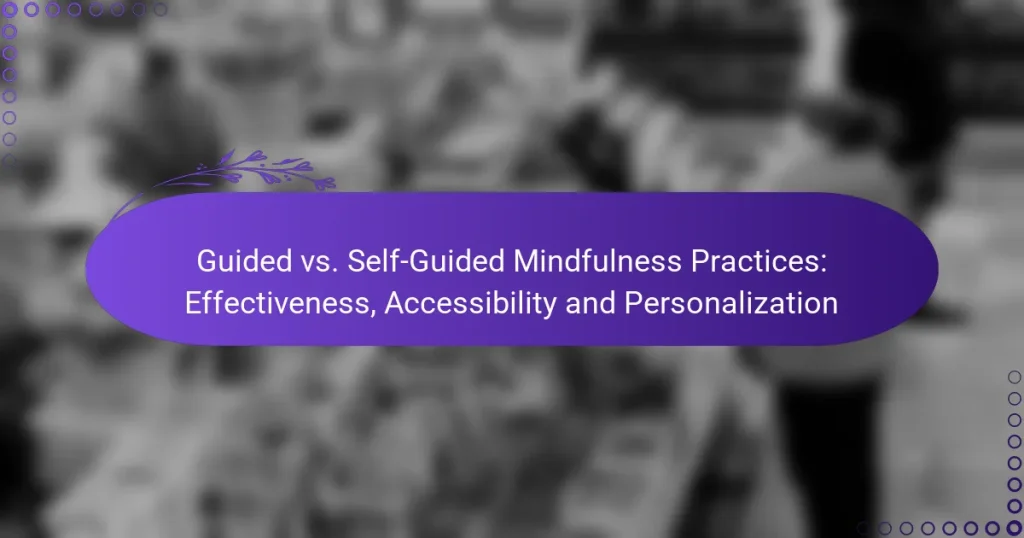Mindfulness practices can be broadly categorized into guided and self-guided approaches, each offering unique benefits. Guided practices provide structured support that enhances focus and emotional regulation, making mindfulness more accessible for beginners. In contrast, self-guided practices allow individuals to cultivate awareness at their own pace, offering flexibility and personalization to fit diverse lifestyles and preferences.
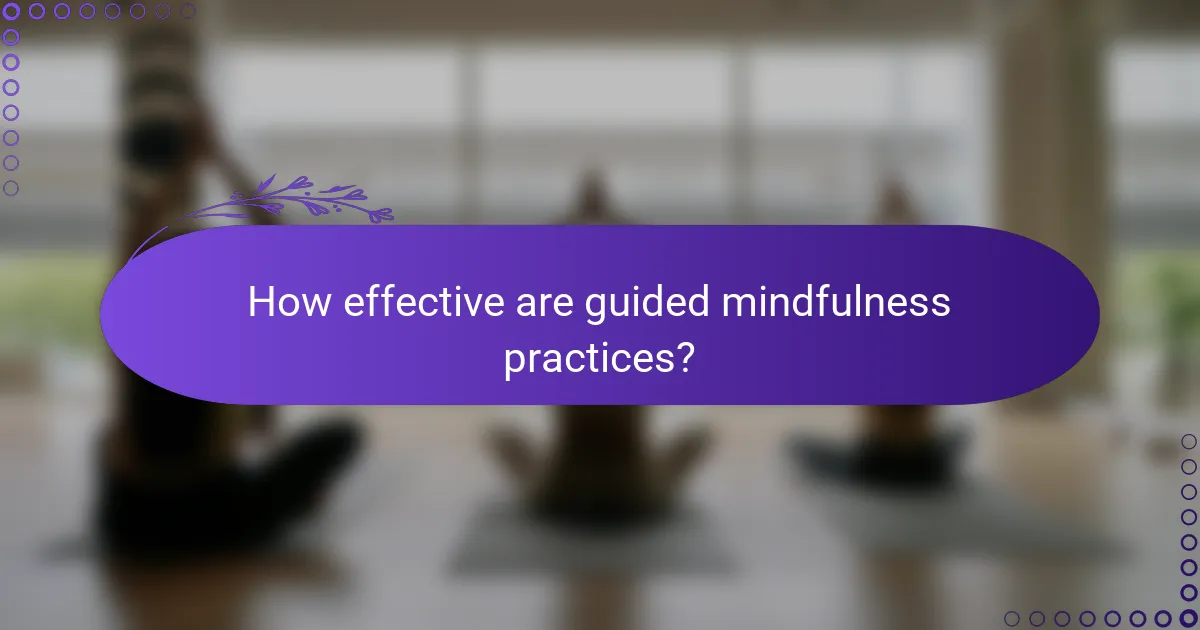
How effective are guided mindfulness practices?
Guided mindfulness practices are generally effective for enhancing focus, reducing stress, and improving emotional regulation. They provide structured support that can lead to deeper engagement and better outcomes compared to self-guided methods.
Higher engagement levels
Guided mindfulness practices often lead to higher engagement levels because they provide clear instructions and a sense of accountability. Participants are more likely to stay focused and committed when they follow a structured session led by an instructor.
For instance, group sessions or apps that offer guided meditations can create a community feel, encouraging regular participation. This social aspect can significantly enhance motivation and adherence to the practice.
Structured learning paths
Guided mindfulness practices typically offer structured learning paths that help individuals progress through various techniques and concepts. These paths can be particularly beneficial for beginners who may feel overwhelmed by the vast array of mindfulness options available.
Many programs are designed to gradually introduce more complex practices, allowing users to build a solid foundation before moving on to advanced techniques. This structured approach can lead to more effective learning and retention of mindfulness skills.
Expert-led sessions
Expert-led sessions in guided mindfulness practices provide access to trained professionals who can tailor the experience to participants’ needs. These experts often share valuable insights and techniques that enhance the overall effectiveness of the practice.
For example, a certified mindfulness instructor can offer personalized feedback and adjustments, ensuring that individuals are practicing correctly and safely. This expert guidance can be particularly beneficial for those dealing with specific challenges, such as anxiety or chronic stress.
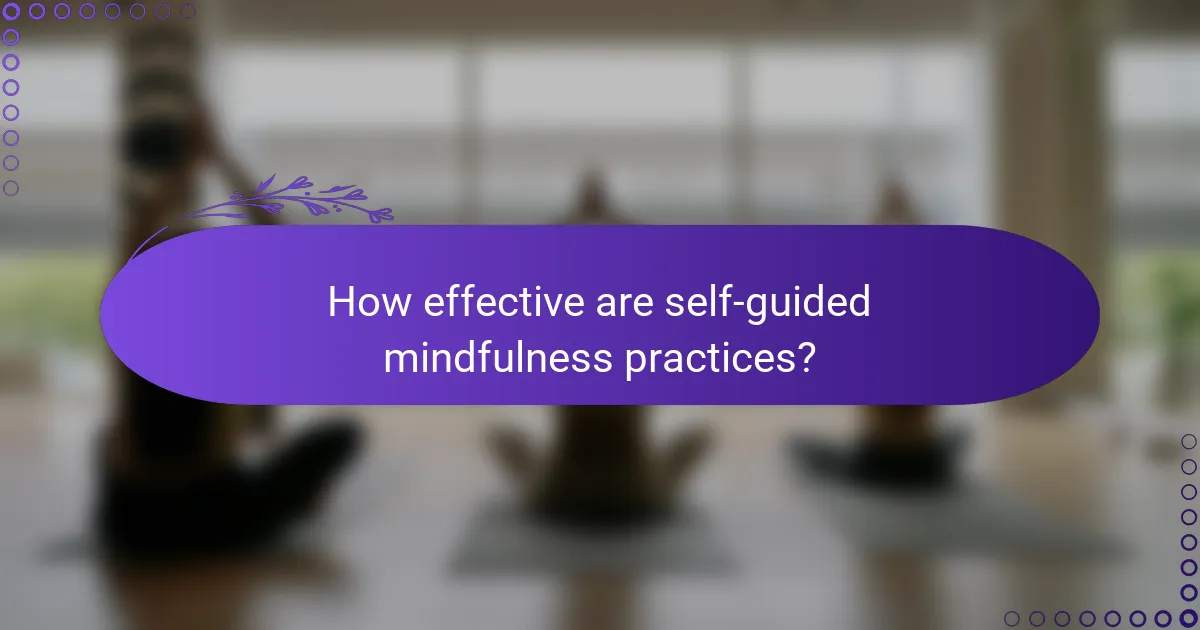
How effective are self-guided mindfulness practices?
Self-guided mindfulness practices can be highly effective, allowing individuals to cultivate awareness and reduce stress at their own pace. These practices often lead to improved mental well-being and can be tailored to fit personal preferences and lifestyles.
Flexibility in scheduling
Self-guided mindfulness offers significant flexibility in scheduling, enabling practitioners to choose when and where to engage in their practice. This adaptability can lead to more consistent engagement, as individuals can fit mindfulness into their daily routines, whether during a lunch break or before bed.
For example, someone may prefer a short session in the morning to start their day with clarity, while another might find evening sessions more beneficial for winding down. This flexibility can enhance the overall effectiveness of the practice.
Personalized pacing
With self-guided mindfulness, individuals can set their own pace, allowing for a more personalized experience. This means practitioners can spend more time on techniques that resonate with them and skip those that do not, which can lead to deeper engagement and understanding.
For instance, a beginner might start with shorter sessions of just a few minutes, gradually increasing the duration as they become more comfortable. This gradual approach can help prevent feelings of overwhelm and encourage sustained practice.
Cost-effective options
Self-guided mindfulness practices are often more cost-effective compared to guided sessions, which may require payment for classes or subscriptions. Many resources, such as apps, online videos, and books, are available for free or at a low cost, making mindfulness accessible to a wider audience.
For example, numerous apps offer free basic features, allowing users to explore mindfulness without financial commitment. This affordability can encourage more people to incorporate mindfulness into their lives, contributing to overall mental health improvement.
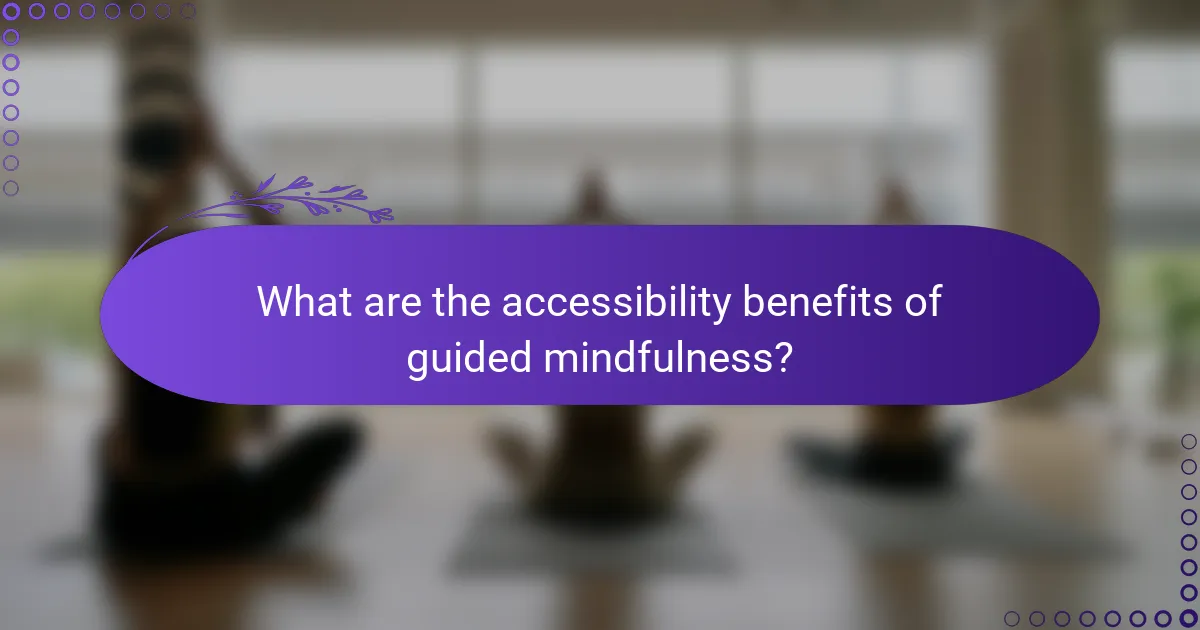
What are the accessibility benefits of guided mindfulness?
Guided mindfulness practices offer significant accessibility benefits by providing structured support and resources that make mindfulness more approachable for individuals. These practices can help users navigate their mindfulness journey, especially for those who may feel overwhelmed or unsure about where to start.
Availability of resources
Guided mindfulness practices often come with a wealth of resources, including audio recordings, mobile apps, and online platforms. Many of these resources are free or available at a low cost, making them accessible to a wide audience. For instance, popular apps like Headspace and Calm offer free trials and a variety of guided sessions tailored to different needs.
Additionally, many community centers and wellness organizations provide free or low-cost group sessions, which can be a great way to access guided mindfulness in a supportive environment. This availability ensures that individuals from various backgrounds can find resources that fit their financial situation and personal preferences.
Supportive community environments
Guided mindfulness practices often foster supportive community environments that enhance the overall experience. Participating in group sessions or online forums allows individuals to share their experiences, challenges, and successes, creating a sense of belonging. This communal aspect can be particularly beneficial for beginners who may feel isolated in their mindfulness journey.
Many local organizations host mindfulness workshops or classes that encourage interaction and support among participants. Engaging with others can motivate individuals to maintain their practice and deepen their understanding of mindfulness techniques. Look for local meetups or online communities that focus on mindfulness to connect with like-minded individuals.
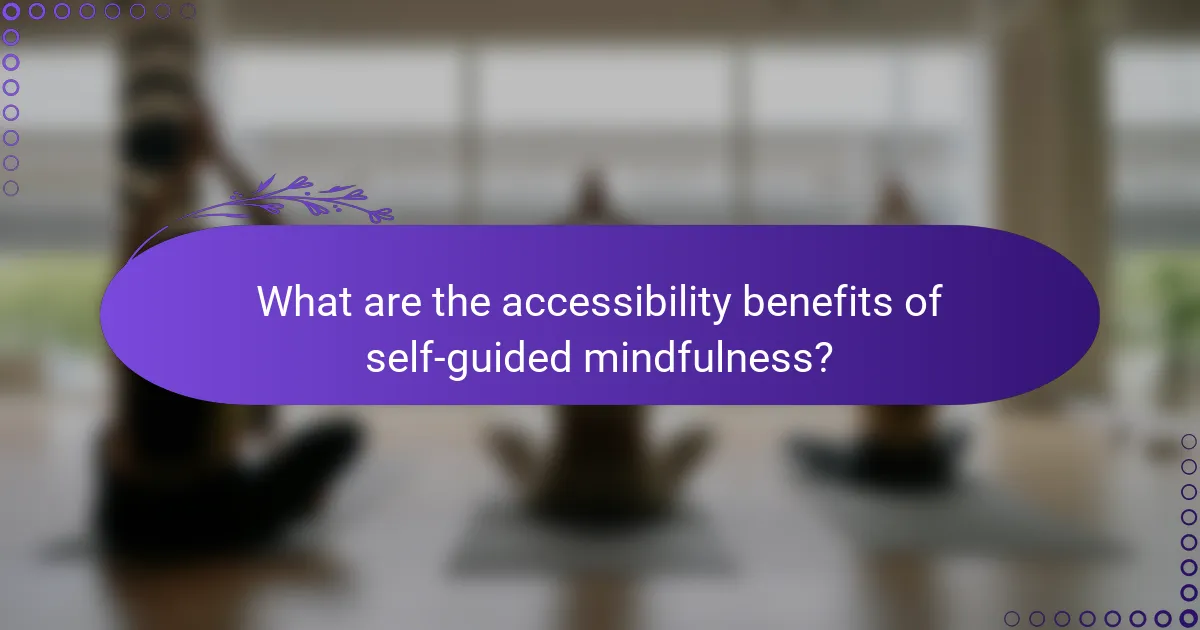
What are the accessibility benefits of self-guided mindfulness?
Self-guided mindfulness practices offer significant accessibility benefits by allowing individuals to engage in mindfulness at their own pace and convenience. This flexibility makes it easier for people to incorporate mindfulness into their daily routines without the constraints of scheduled classes or guided sessions.
Anytime access to materials
Self-guided mindfulness resources are available 24/7, enabling individuals to practice whenever it suits them. This can be particularly beneficial for those with irregular schedules or varying commitments, as they can choose to engage in mindfulness exercises during quiet moments throughout the day.
For example, someone may prefer to practice mindfulness in the early morning or late at night, depending on their personal schedule. This adaptability helps to foster a consistent mindfulness practice, which is essential for long-term benefits.
Wide range of platforms
Self-guided mindfulness is accessible through various platforms, including mobile apps, websites, and audio recordings. This diversity allows users to select the format that best fits their learning style and preferences.
Popular mindfulness apps often include features like guided meditations, progress tracking, and community support, enhancing the overall experience. Additionally, many resources are available for free or at a low cost, making mindfulness practices more attainable for a broader audience.
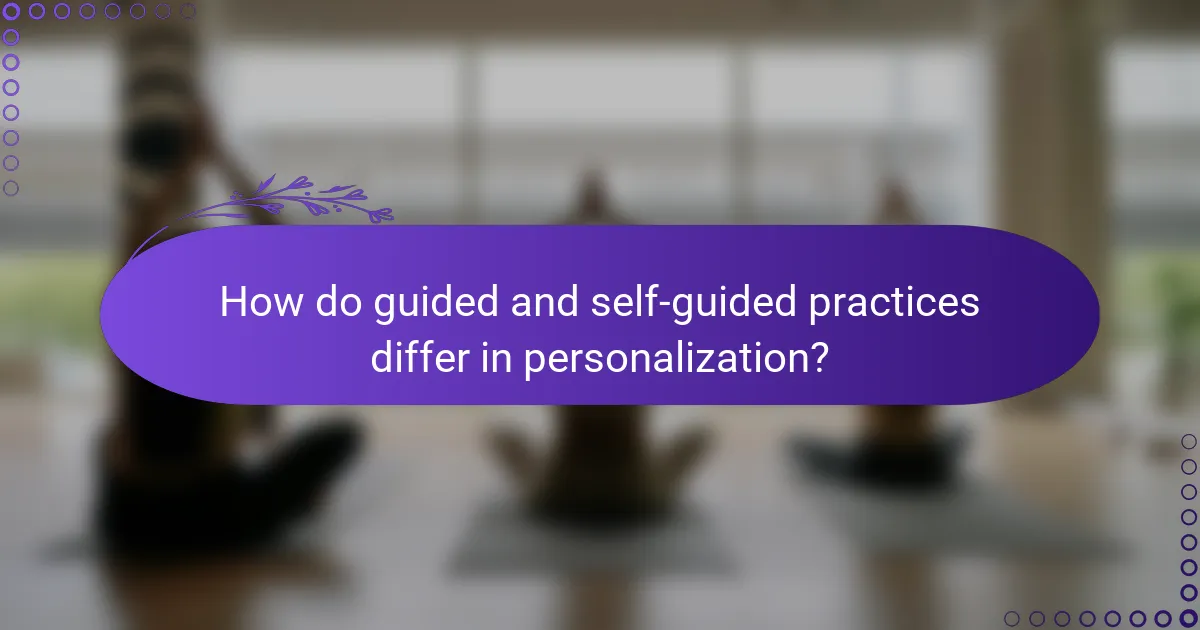
How do guided and self-guided practices differ in personalization?
Guided and self-guided mindfulness practices differ significantly in their level of personalization. Self-guided practices allow individuals to tailor their experiences based on personal preferences, while guided sessions often follow a structured approach designed by an instructor.
Customizable experiences in self-guided
Self-guided mindfulness practices offer a high degree of customization, enabling individuals to choose techniques that resonate with them. Users can select the duration, type of meditation, and specific focus areas, such as stress relief or emotional regulation.
For example, someone may prefer a short, five-minute breathing exercise during a busy workday, while another might opt for a longer, more in-depth session on compassion. This flexibility allows practitioners to adapt their mindfulness routines to fit their daily schedules and emotional needs.
Targeted approaches in guided sessions
Guided mindfulness sessions typically provide a more targeted approach, often focusing on specific themes or goals. These sessions are led by experienced instructors who design the content to address particular issues, such as anxiety reduction or enhancing focus.
For instance, a guided session may incorporate visualization techniques aimed at fostering relaxation, which can be particularly beneficial for beginners who may struggle with self-direction. This structured guidance can help participants achieve deeper insights and more effective outcomes.
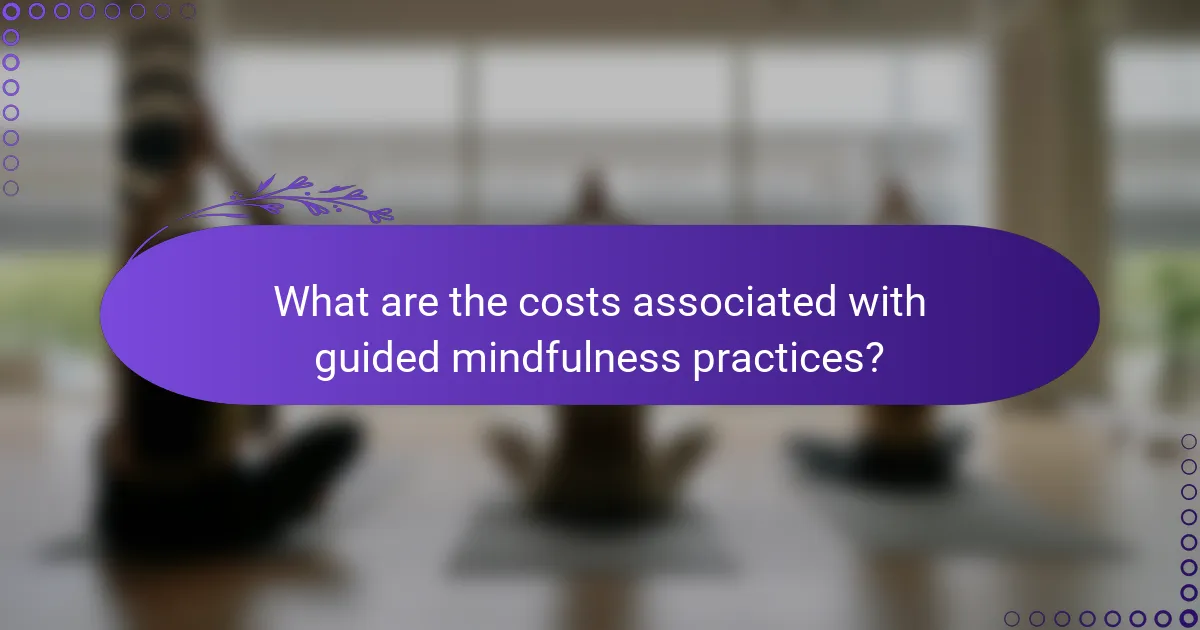
What are the costs associated with guided mindfulness practices?
Guided mindfulness practices often involve various costs that can vary significantly based on the format and provider. These costs may include membership fees, session prices, and additional resources like apps or materials.
Membership fees for studios
Membership fees for mindfulness studios can range from low monthly rates to higher annual subscriptions. Typically, these fees may fall between $30 to $150 per month, depending on the location and the variety of classes offered.
When considering a studio membership, evaluate what is included, such as unlimited classes, access to special workshops, or discounts on events. Some studios may offer introductory rates or trial periods, which can help you assess their offerings before committing financially.
Be mindful of cancellation policies and any additional costs for special classes or events that may not be covered under the membership. This will help you avoid unexpected expenses while pursuing your mindfulness practice.
